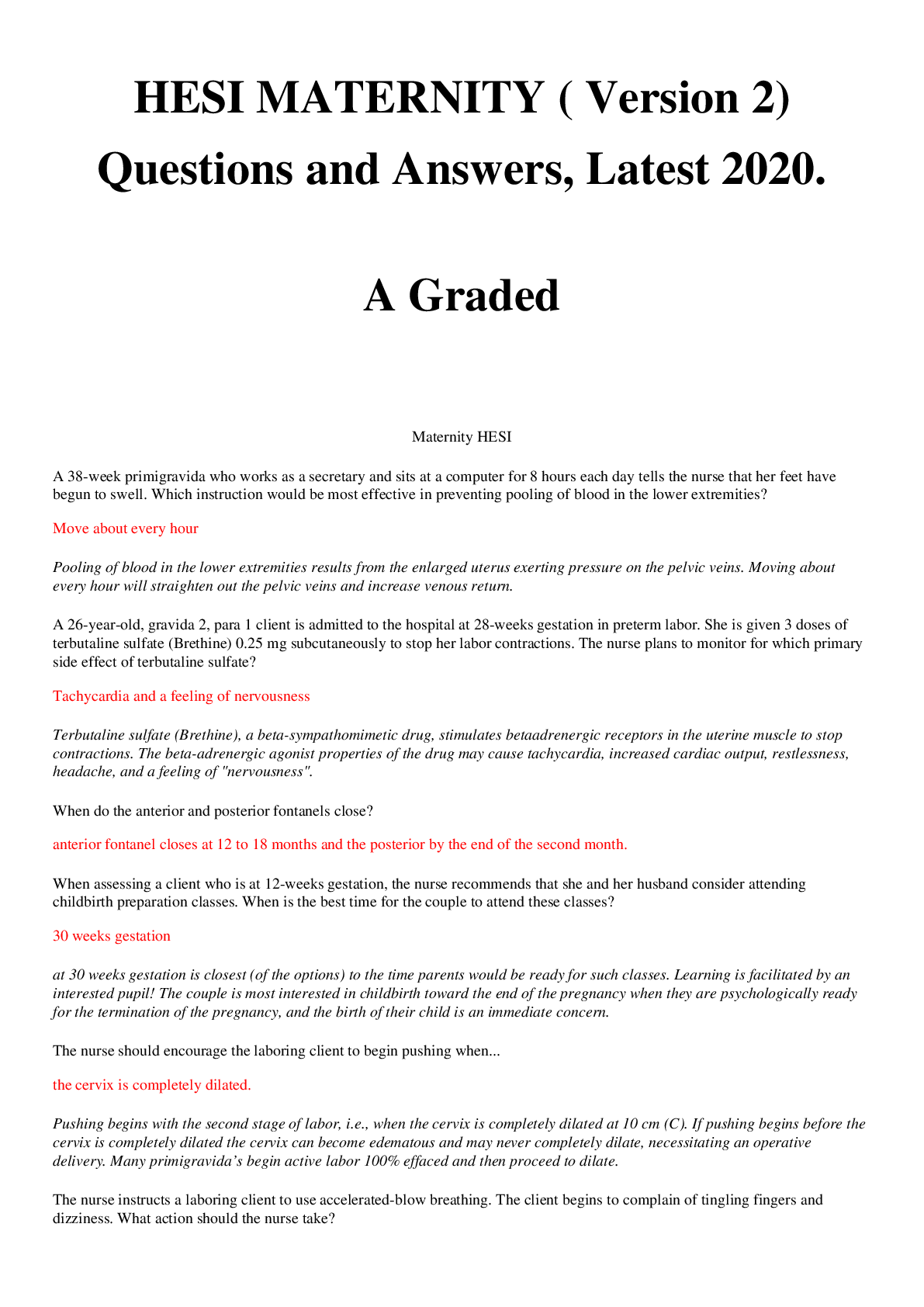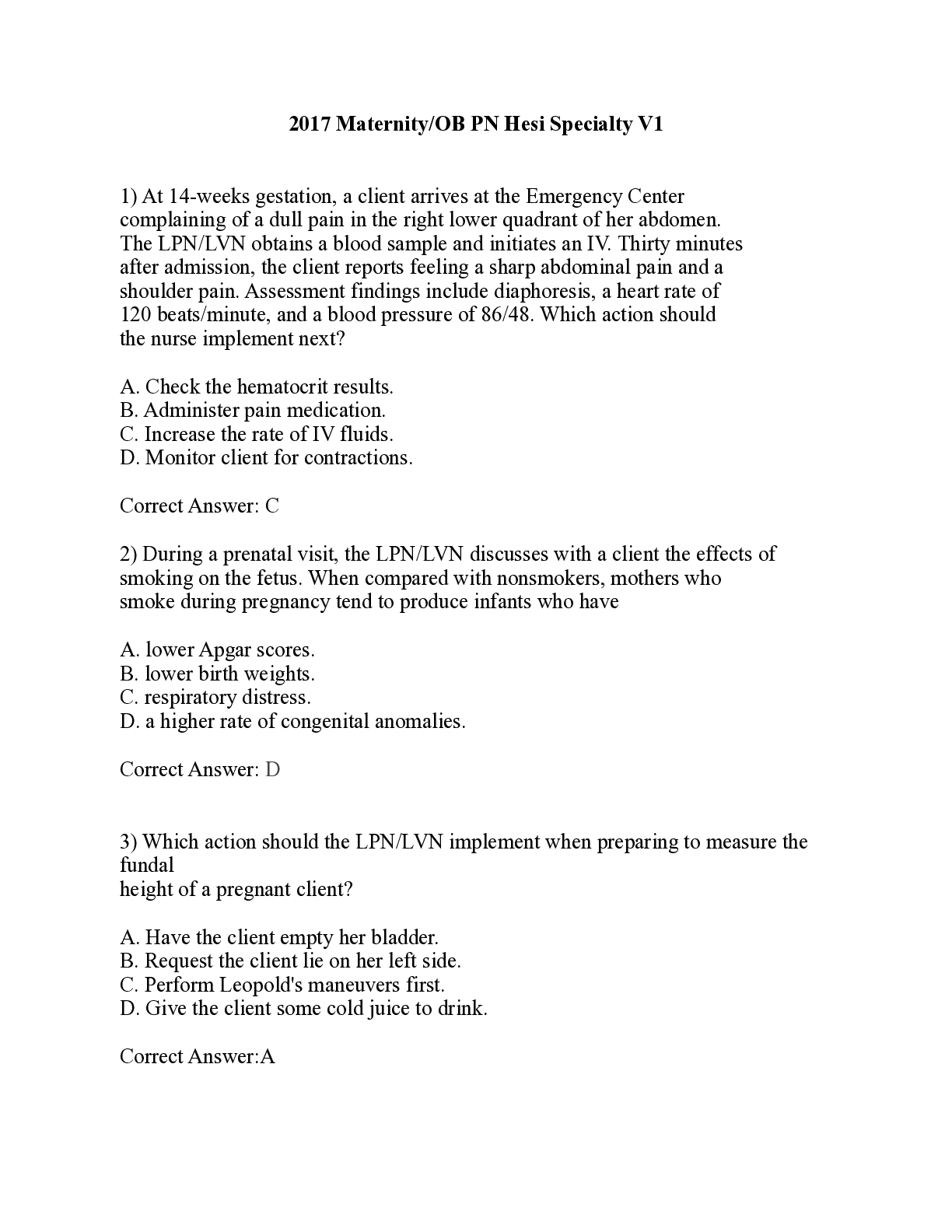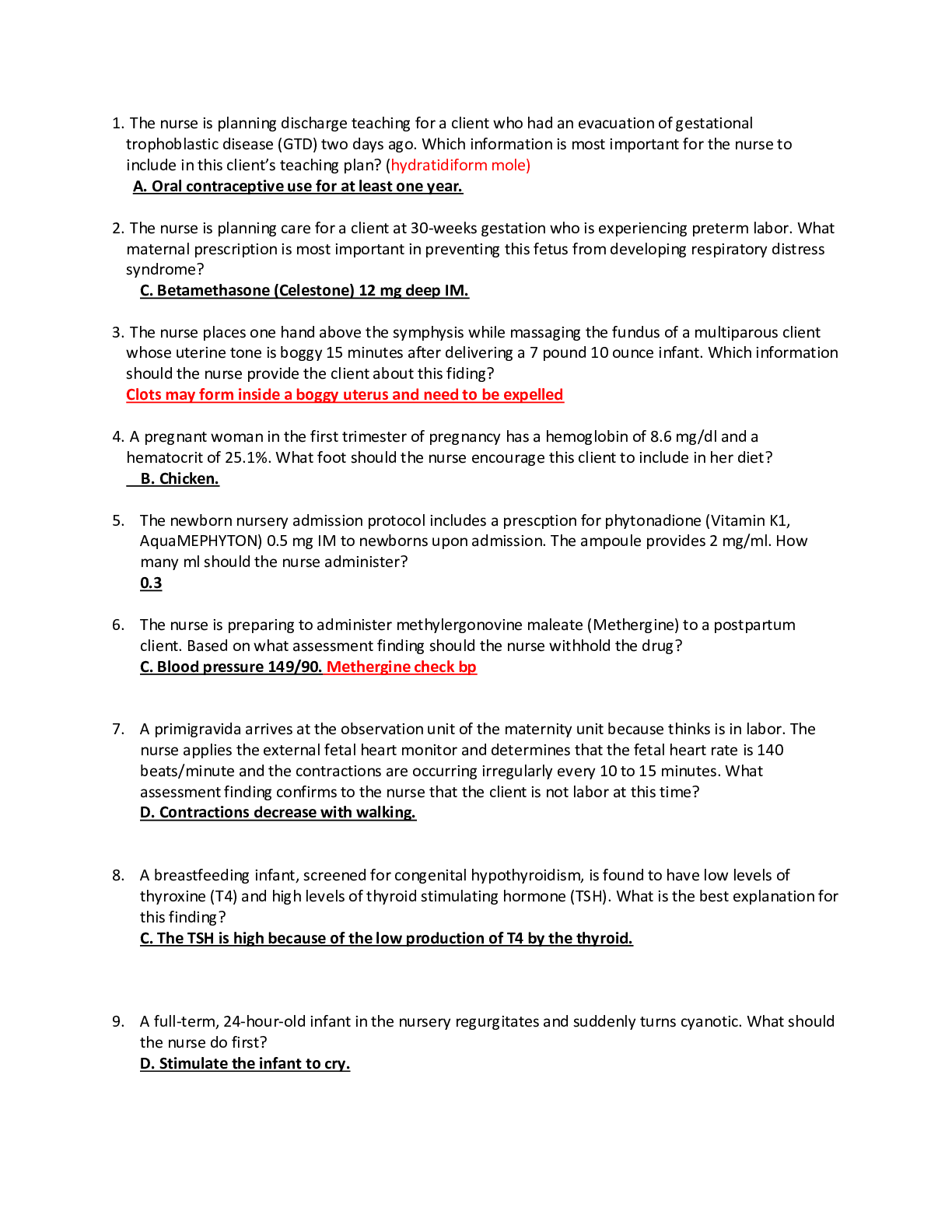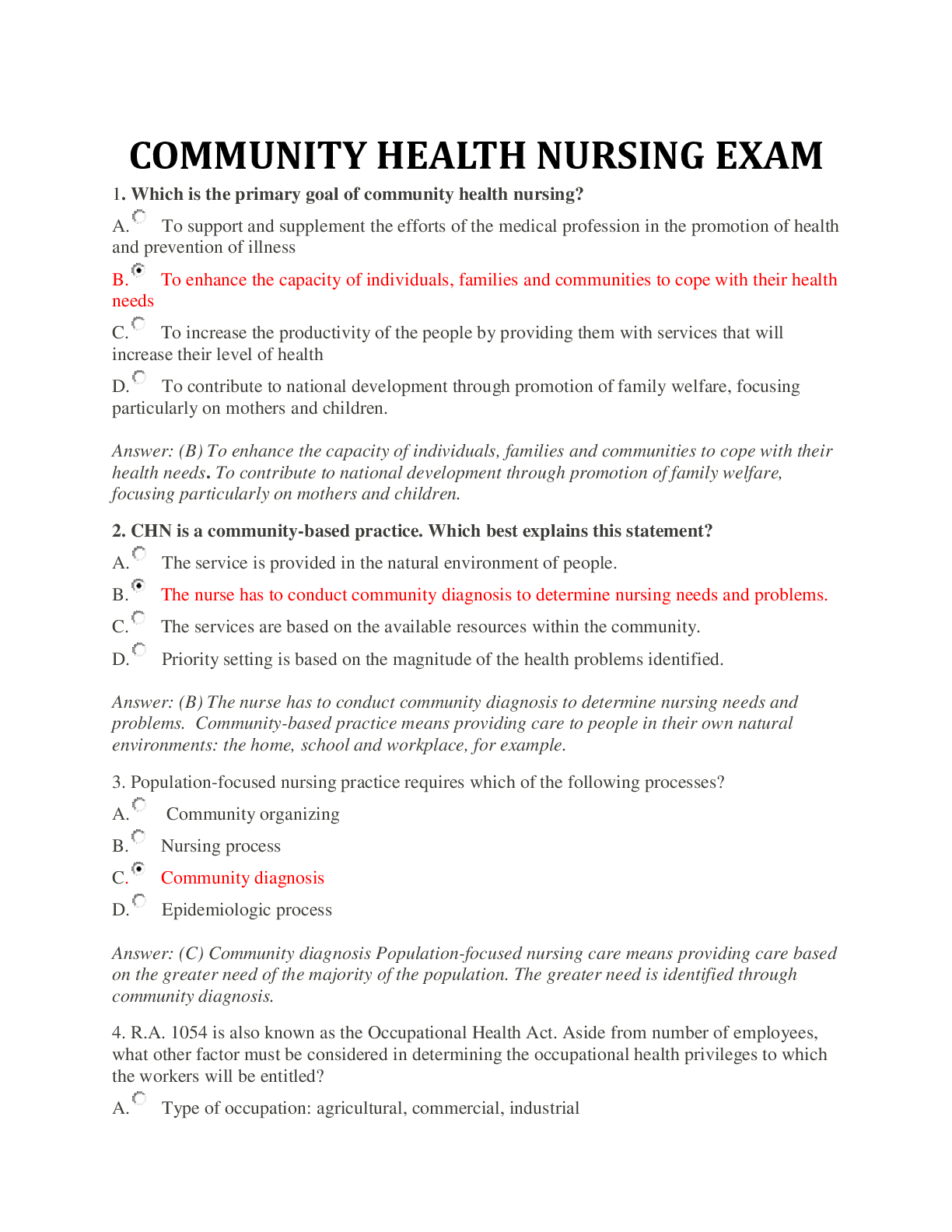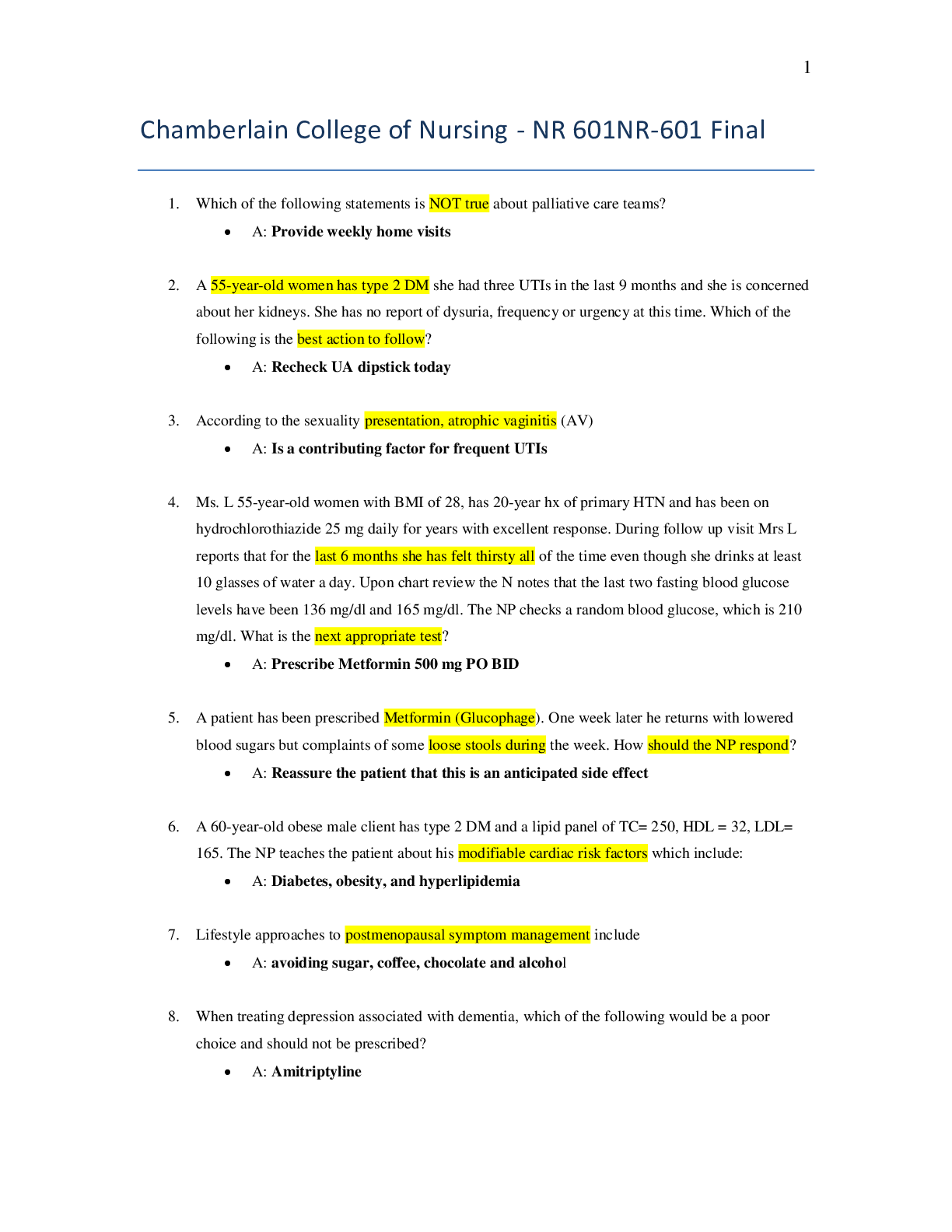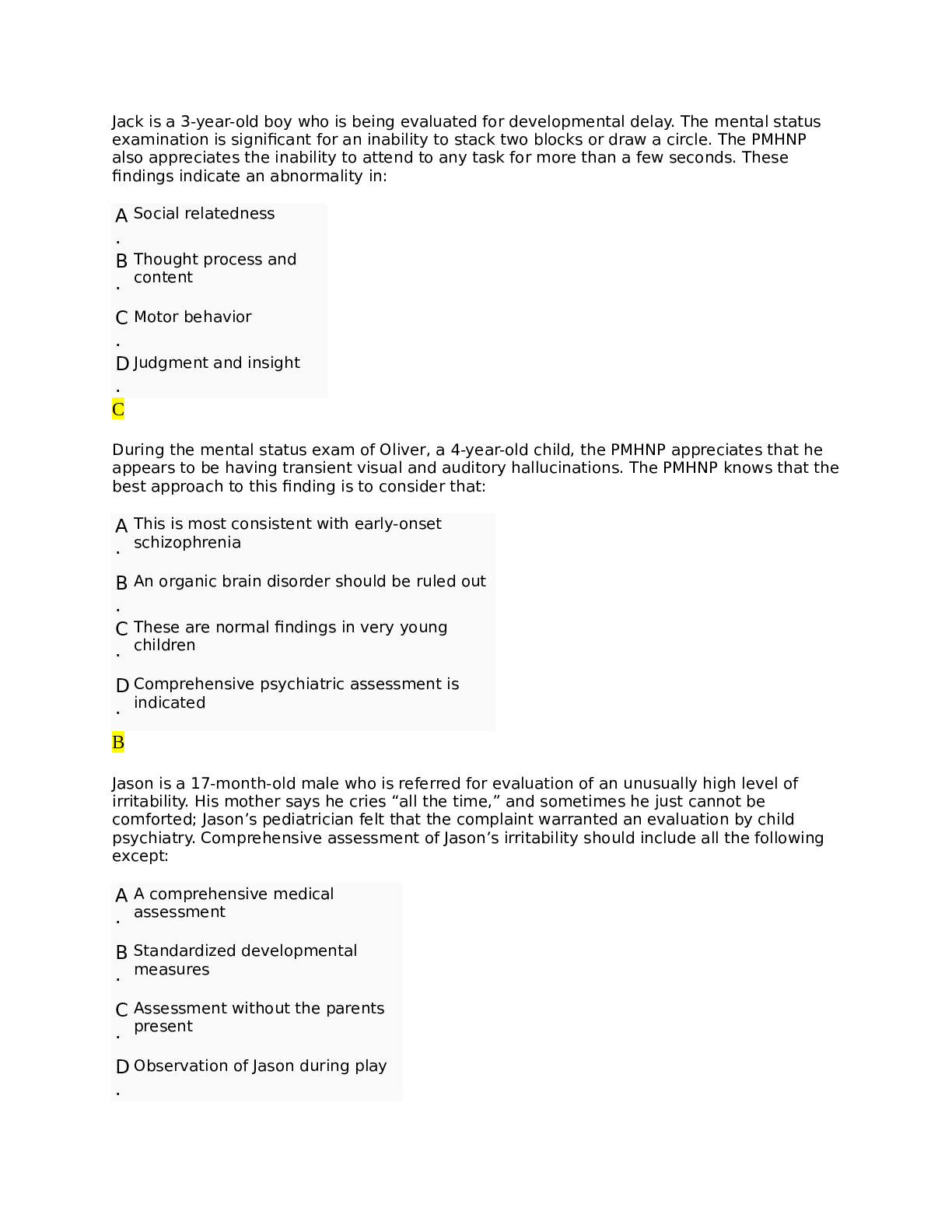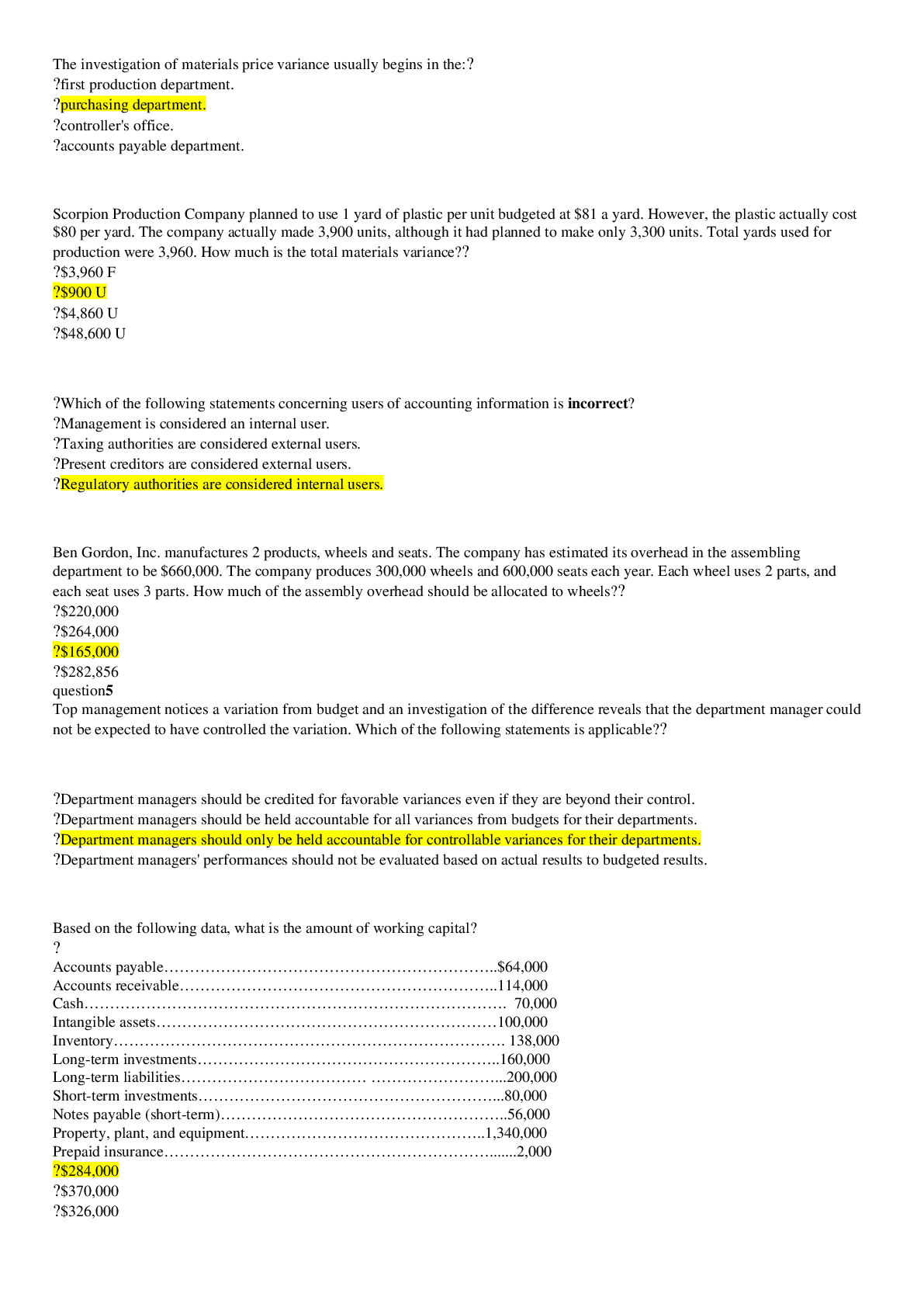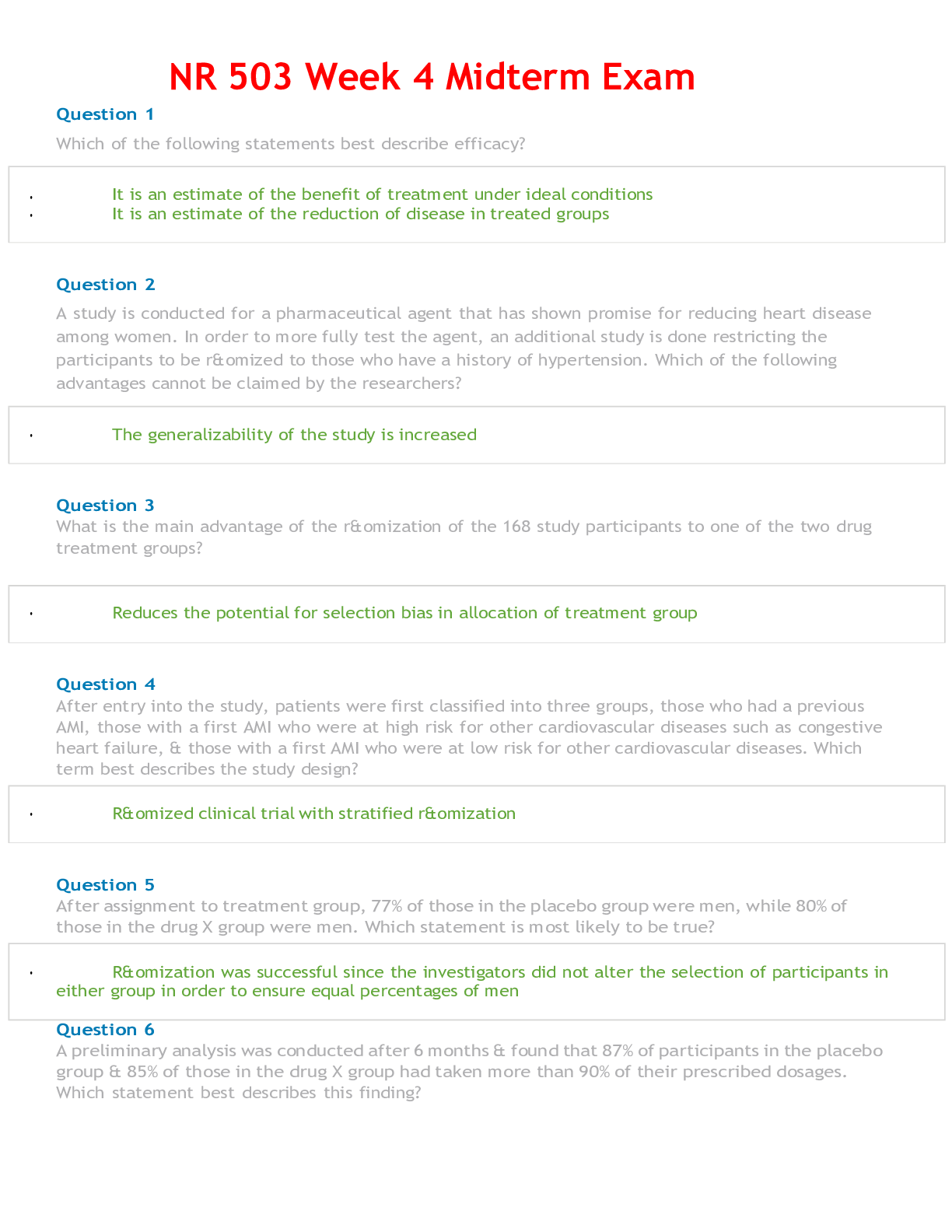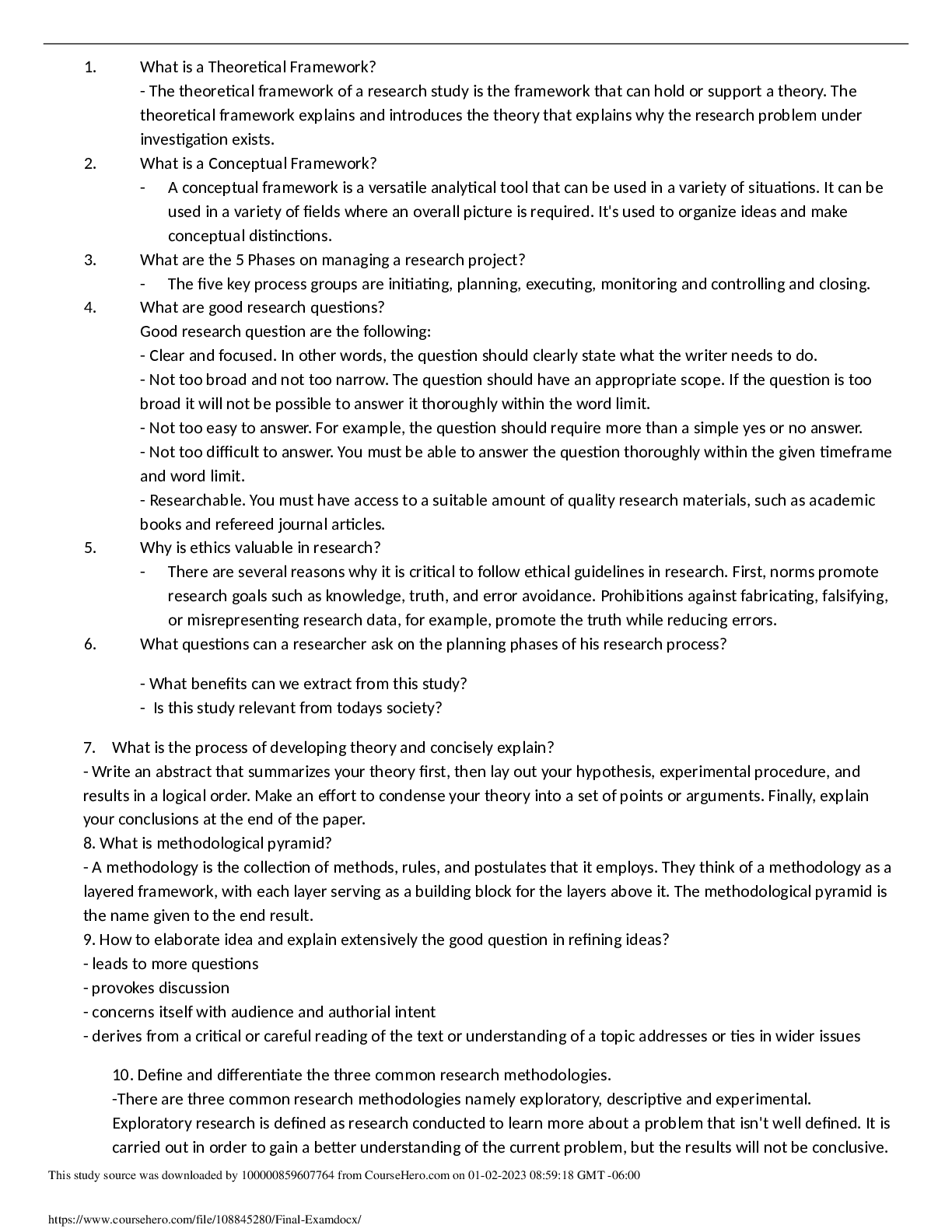CPC FINAL EXAM. QUESTIONS AND ANSWERS. LATEST 2020/21. A+ GRADED
Document Content and Description Below
CPC Final with Answers 10000 Series 1. While whittling a piece of wood, the patient sustained an avulsion injury to a portion of his left index finger and underwent formation of a direct pe... dicle graft with transfer from his left middle finger. Immobilization was accomplished with a plaster splint. What CPT® code is reported? a. 15574 c. 15750 b. 15740 d. 15758 ANS: A Rationale: In the CPT® Index look for Pedicle Flap/Formation, you are directed to 15570-15576. Code selection is based on location. Subsection guidelines for Flaps state the codes refer to the recipient site not the donor site. The term pedicle indicates this is a flap not a direct graft, where skin is removed from one site and transferred to another. Instead, a flap of skin is raised, leaving it attached to its source location to maintain blood supply until it is established sufficiently in the new site. Code 15574 describes a direct pedicle graft of the hands with or without transfer. 2. A 3 year-old is brought to the burn unit after pulling a pot of hot soup off the stove and spilling it on herself. She sustained 18% second degree burns on her legs and 20% third degree burns on her chest and arms. Total body surface area burned is 38%. What ICD-10-CM codes are reported for the burns (do not include external cause codes for the accident)? a. T21.21XA, T22.20XA, T24.209A, T31.23 b. T21.31, T22.20, T24.209, T31.32 c. T21.31XA, T22.399A, T24.299A, T31.32 d. T21.31XA, T22.20XA, T24.209A, T31.32 ANS: C Rationale: ICD-10-CM guideline I.C.19.d.1 states to sequence first the code that reflects the highest degree of burn when more than one burn is present. In this case, the burns on her chest and arms are third degree and are reported first. In the ICD-10-CM Alphabetic Index look for Burn/chest wall/third degree, referring you to subcategory T21.31. Because the question indicates arms and legs (plural) we will code multiple sites of the upper and lower limbs. In the Alphabetic Index look for Burn/upper limb/multiple sites/third degree directing you to subcategory T22.399, and Burn/lower/limb/multiple sites/second degree directing you to subcategory T24.299. The Tabular List indicates a 7th character is needed for all three of these codes; a placeholder X is required for T21.31. The 7th character A is reported for the initial encounter. Refer to ICD-10-CM guideline I.C.19.d.6 for instructions on assigning a code from category T31 to report the extent of body surface involved. The 4th character represents the total body surface area (TBSA) (all degrees) that was burned. The 5th character represents the percentage of third degree burns to the body. In the scenario, 38% is documented as the TBSA making 3 the appropriate 4th character; 20% is third degree burns, making 2 the 5th character. In the Alphabetic Index look for Burn/extent (percentage of body surface)/30-39 percent/with 20-29 percent third degree burns directing you to code T31.32. The external cause codes would also be reported for the accident. Verify code selection in the Tabular List. 3. Patient is an 81-year-old male with a biopsy proven basal cell carcinoma of this posterior neck just near his hairline; additionally the patient had two additional areas of concern on his cheek. Informed consent was obtained and the areas were prepped and draped in the usual sterile fashion. Attention was first directed to the basal cell carcinoma of the neck, I excised the lesion measuring 2.6 cm as drawn down to the subcutaneous fat. With extensive undermining of the wound I closed in layers using 4.0 Monocryl, 5.0 Prolene and 6.0 Prolene; the wound measured 4.5cm. Attention was then directed to the other two suspicious lesions on his cheek; after administering local anesthesia I proceeded to take a 3mm punch biopsy of each lesion and was able to close with 5.0 Prolene. The patient tolerated the procedures well. Pathology later showed the basal cell carcinoma was completely removed and the biopsies indicated actinic keratosis. What CPT® codes should be reported? a. 13132, 11623-51, 11100-59, 11101 c. 12042, 11623-51, 11100-59, 11101 b. 13131, 11622-51, 11100-59, 11100-59 d. 13132, 11623-51, 11440-51, 11440-51 ANS: A Rationale: Three lesions were addressed. The first lesion is a malignant neoplasm of the neck (basal cell carcinoma). Look in the CPT® Index for Skin/Excision/Lesion/Malignant. This refers you to code range 11600-11646. The range is narrowed by the location (neck, 11620-11626). The excision was 2.6 cm making 11623 the correct code. For this lesion, extensive undermining of the wound and the use of multiple suture materials support use of a complex closure. Complex repairs are indexed under Repair/Skin/Wound/Complex referring you from range 13100-13160. The range is narrowed again by location (neck, 13131-13133). The repair length is 4.5 cm making 13132 the correct code. After the lesion of the neck is removed the provider took two biopsies on the cheek. Look in the CPT® Index for Skin/Biopsy which refers you to codes 11100 and 11101. 11100 is used for the first biopsy and add-on code 11101 for the additional biopsy. Biopsies are typically included in excisions. It is necessary to use modifier 59 for the first biopsy indicating it was performed at a different location than the excision. A modifier 59 is not used on the second biopsy code because it is an add-on code. 4. Patient is a 53-year-old female who yesterday underwent Mohs surgery with Dr. Smith to remove a basal cell carcinoma of her scalp. Due to the size of the defect Dr. Smith requested a Plastic Surgeon to reconstruct the site. Dr. Jones discussed with the patient his planned closure which was a Ying-Yang type flap. The patient agreed and we proceeded. The area was prepped and draped in a sterile fashion being careful to keep betadine solution out of the open wound. Wound preparation was done by excising an additional 1 mm margin to freshen the wound and excising the wound deeper. Starting on the right, Dr. Jones incised his planned flap, elevating the flap with full-thickness and subcutaneous fat, staying superior to the galea; then Dr. Jones incised his planned flap on the left elevating the flap with full-thickness and subcutaneous fat. Both flaps were rotated together and the wound was temporarily closed using the skin stapler. Once it was determined there was minimal tension on the wound; the galea was approximated using 4.0 Monocryl. The wound was then closed in layers using 5-0 Monocryl and a 35R skin stapler. Meticulous hemostasis was achieved through-out the procedure with the Bovie cautery. Final measurements of the wound were 36.25 cm squared. What CPT® code(s) is/are reported? a. 14021-22 c. 14301 b. 14021, 15004-51 d. 14301, 15004-51 ANS: D Rationale: A Ying Yang flap is a rotation flap coded using Adjacent Tissue Transfer codes. In the CPT® Index, look for Skin Graft and Flap/Tissue Transfer and you are directed to codes 14000-14350. When the defect size is less than 30 sq. cm, it is coded based on location and size. When it is more than 30 sq. cm, it is coded using 14301 and 14302. In this case, we have a flap 36.25 sq. cm. 14301 is reported for the first 30 sq. cm – 60.0 sq. cm. Wound preparation was also performed, in the CPT® index look for Integumentary System/Skin Replacement Surgery and Skin Substitutes/Surgical Preparation referring you to codes 15002-15005. Code 15004 is reported for the scalp. Modifier 51 is used to indicate multiple procedures were performed. 5. Patient presents to the emergency department with multiple lacerations due to a knife fight at the local bar. After examination it was determined these lacerations could be closed using local anesthesia. The areas were prepped and draped in the usual sterile fashion. The surgeon documented the following closures: 7.6 cm simple closure of the right forearm; 5.7 cm intermediate closure of the upper right arm; 4.7 cm complex closure of the right neck; 10.3 cm intermediate closure of the upper chest. What CPT® codes are reported? a. 13132, 12035-59, 12004-59 b. 13132, 12034-59, 12032-59, 12004-59 c. 13132, 12036-59 d. 13152, 12035-59, 12004-59 ANS: A Rationale: Four lacerations are repaired. The lacerations are separated first by classification (simple, intermediate, complex); then by location. There is one simple closure which is 7.6 for the right forearm (12004). Next the intermediate closures are performed on the arm measuring 5.7 cm and the upper chest measuring 10.3 cm. Trunk (chest) and extremities (arm) are in the same classification and are both intermediate, so the lengths are added together to total 16 cm (12035). The last repair is a complex repair of the neck, 4.7 cm (13132). Subsection guidelines state to append Modifier 59 to indicate that multiple repair procedures are performed. These codes are indexed in CPT® under Skin/Wound Repair. 6. Patient presents to the operative suite with a biopsy proven squamous cell carcinoma of the left ankle. A decision was made to remove the lesion and apply a split thickness skin graft on the site. The lesion was excised as drawn and documented as measuring 2.4 cm with margins. Using the Padgett dermatome the surgeon harvested a split-thickness skin graft from the left thigh, which was meshed 1.5 x 1 and then inset into the ankle wound using a skin stapler. Xeroform bolster was then placed on the skin graft using Xeroform and 4-0 nylon and the lower extremity was wrapped with bulky cast padding and double Ace wrap. The skin graft donor site was dressed with OpSite. The surgeon noted the skin graft measured 9cm² in total. What CPT ® and ICD-10-CM codes are reported? a. 15100, 11603-51, C44.729 c. 15120, 13100-51, D22.72 b. 15100, C44.729 d. 15240, 11603-51, C44.729 [Show More]
Last updated: 1 year ago
Preview 1 out of 37 pages
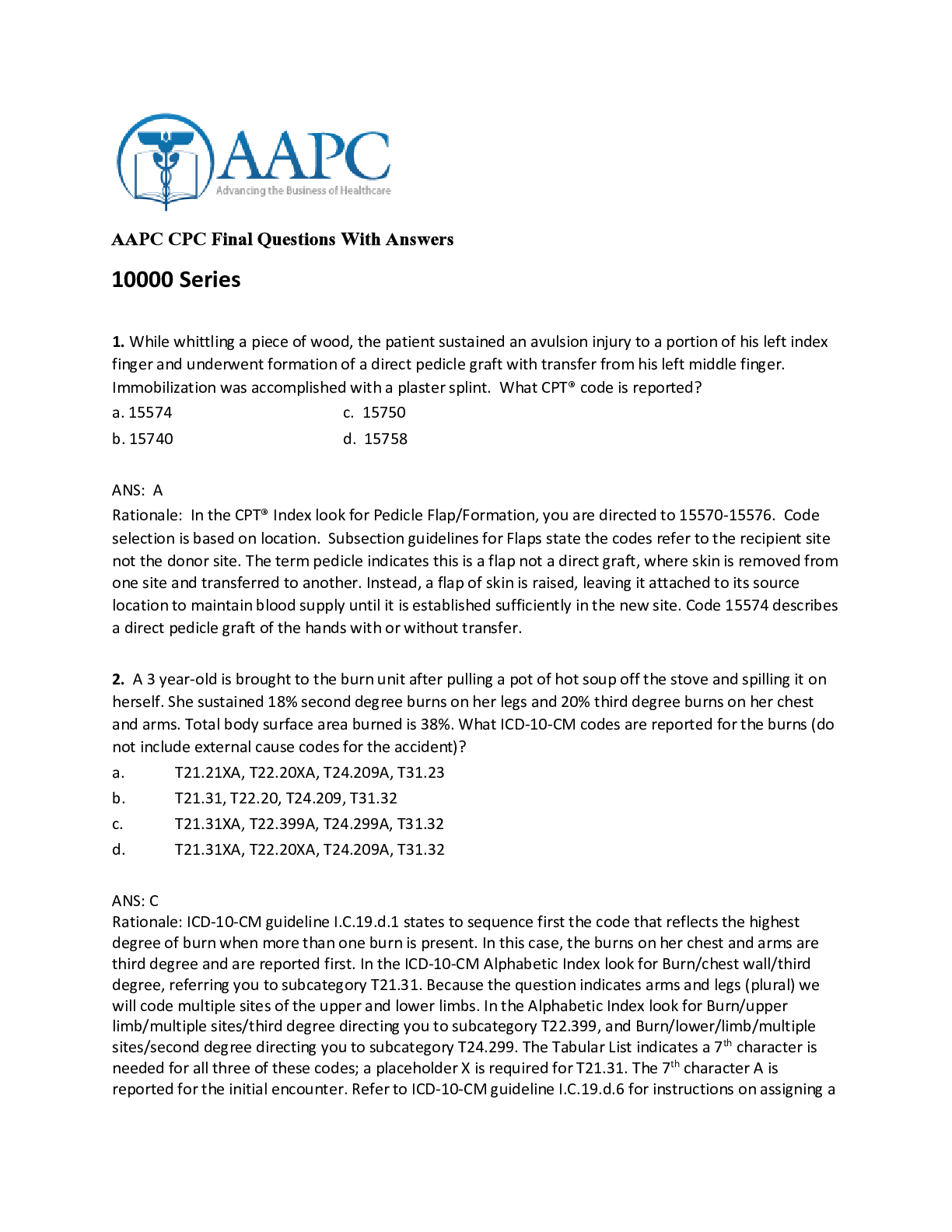
Buy this document to get the full access instantly
Instant Download Access after purchase
Add to cartInstant download
We Accept:

Reviews( 0 )
$17.00
Document information
Connected school, study & course
About the document
Uploaded On
Feb 21, 2021
Number of pages
37
Written in
Additional information
This document has been written for:
Uploaded
Feb 21, 2021
Downloads
0
Views
117


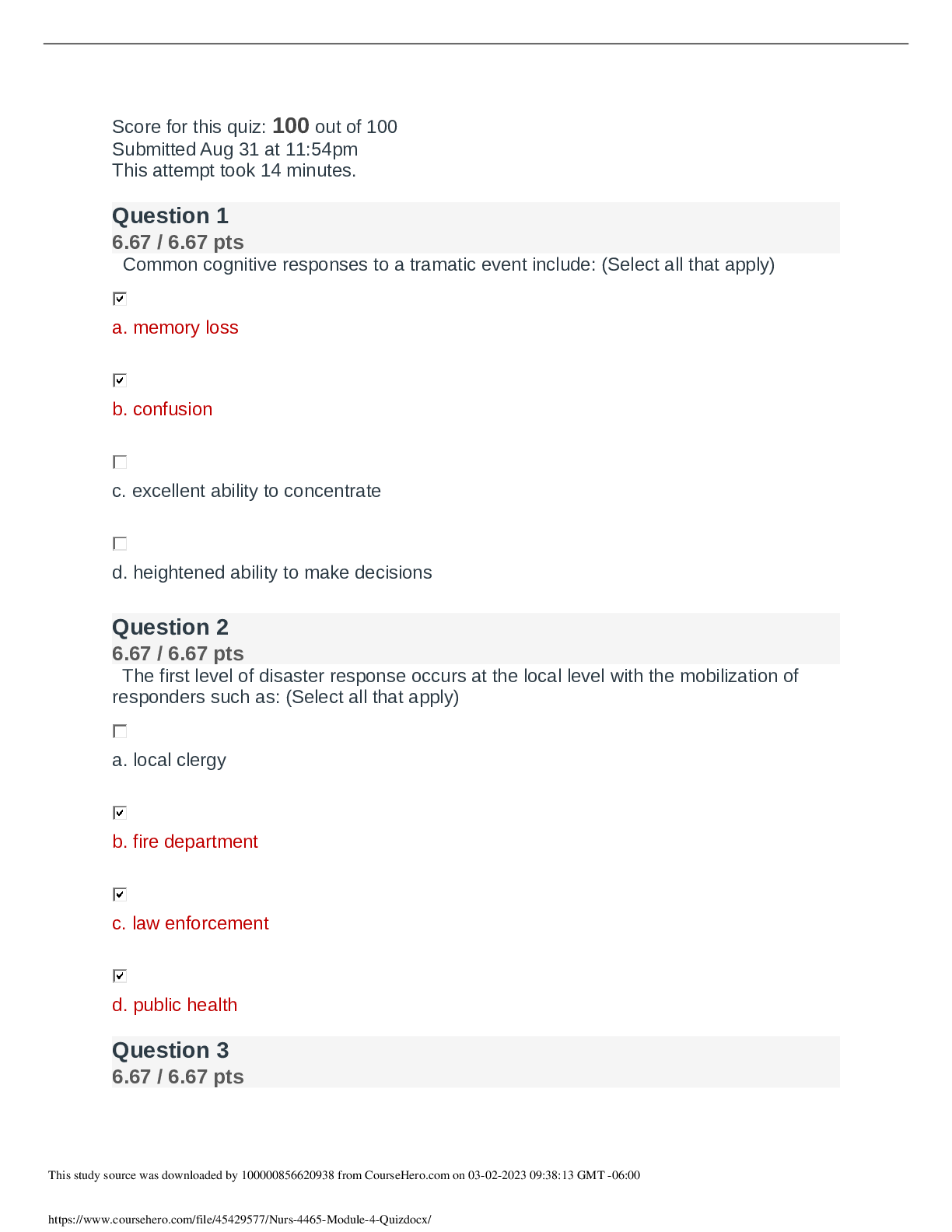
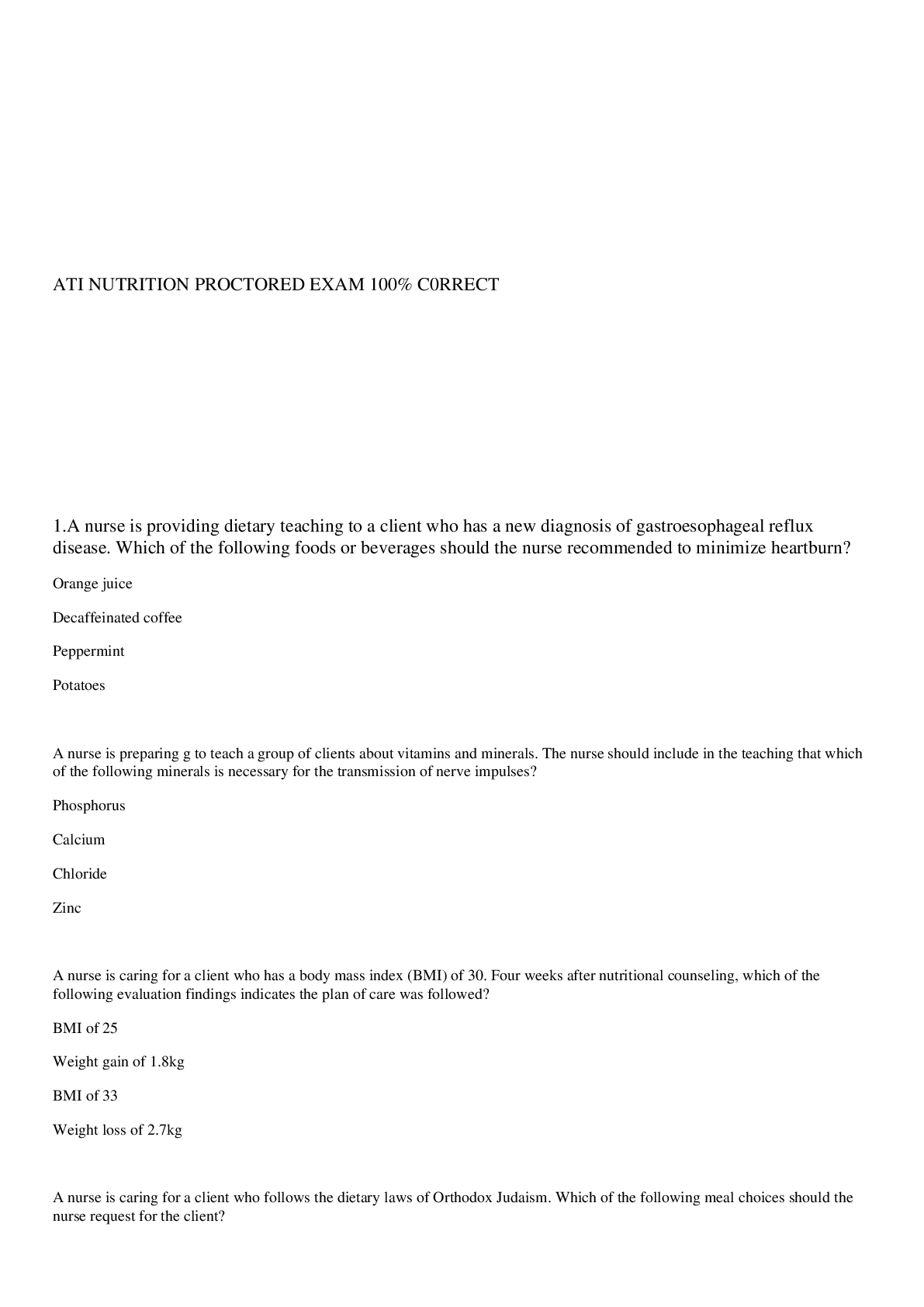
.png)
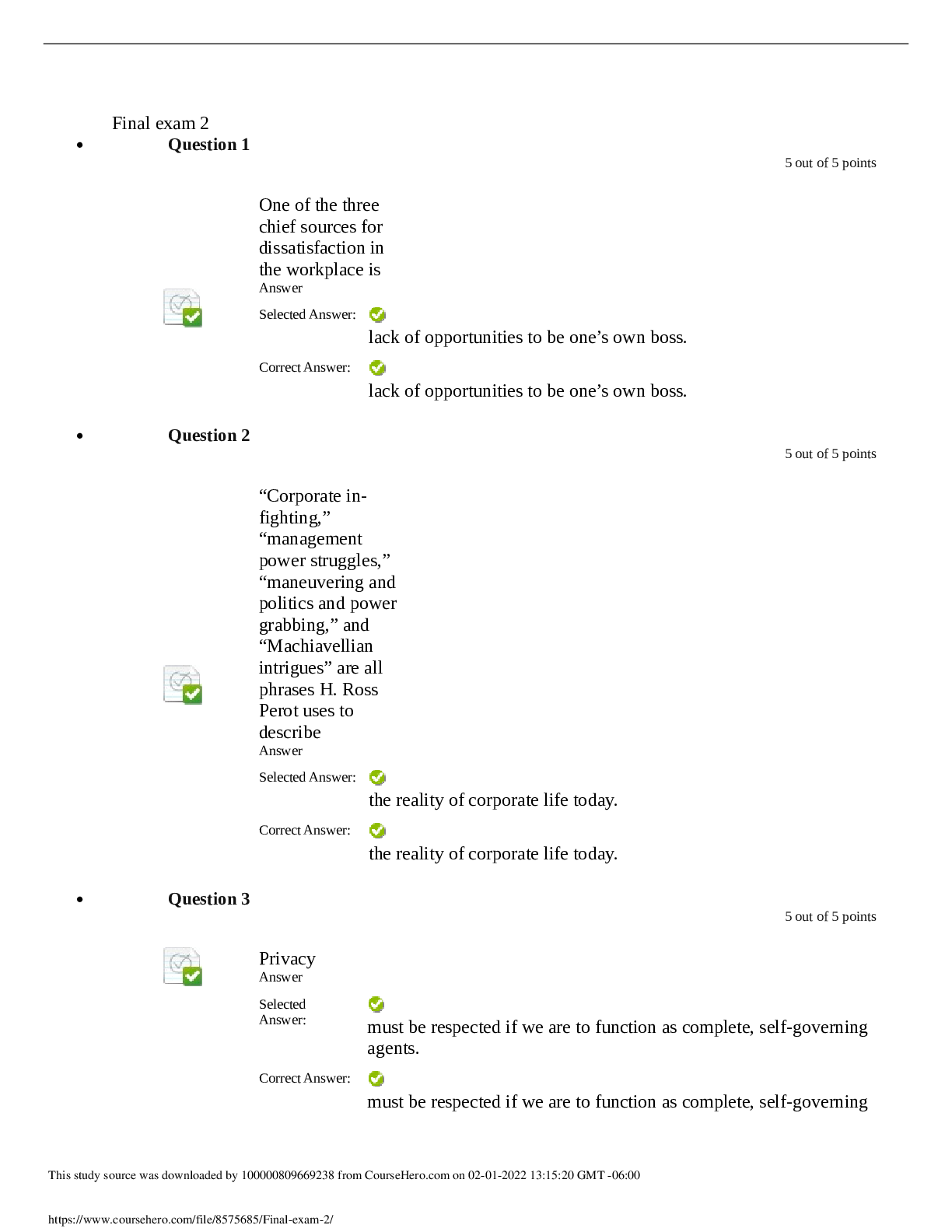
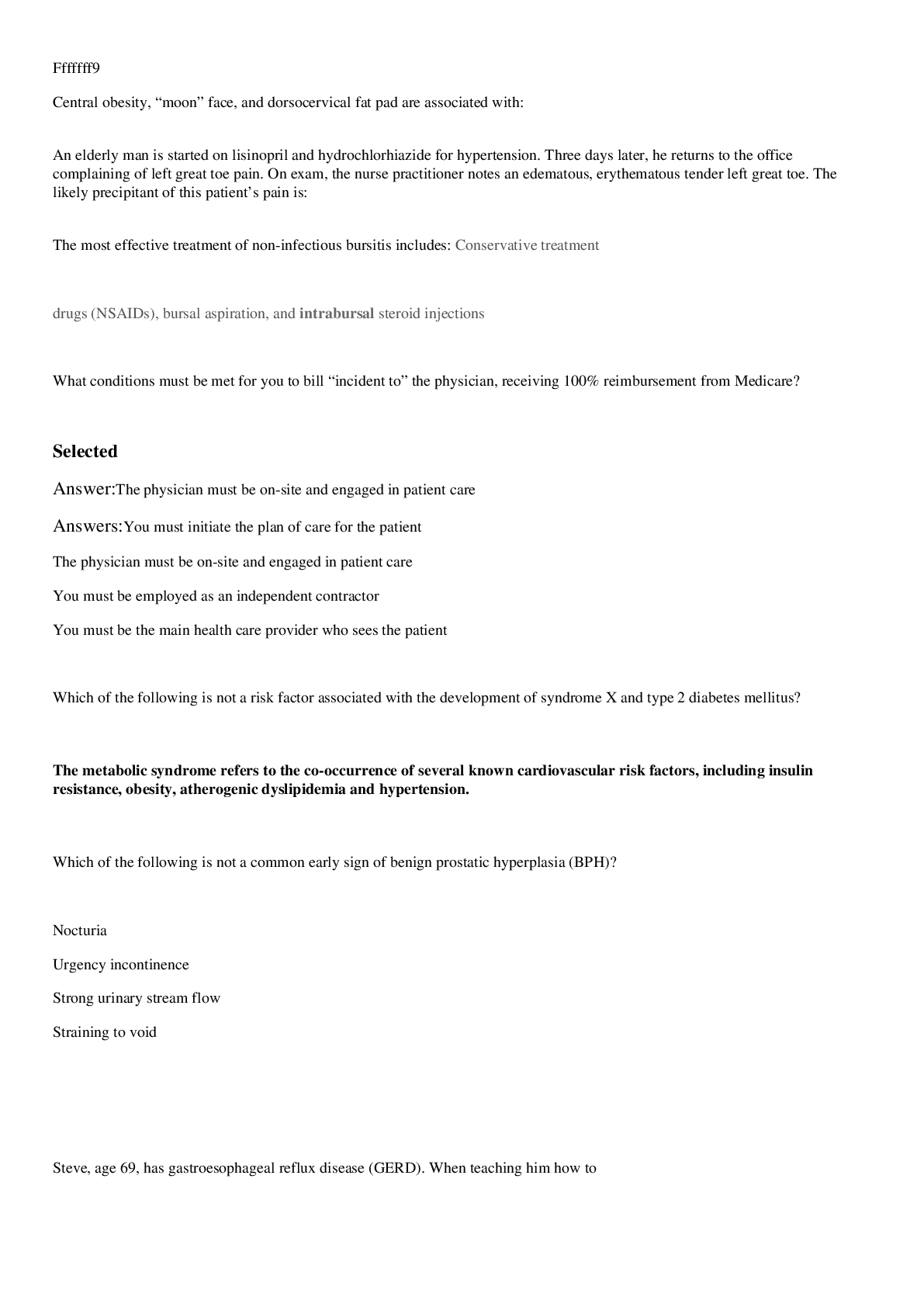

.png)
